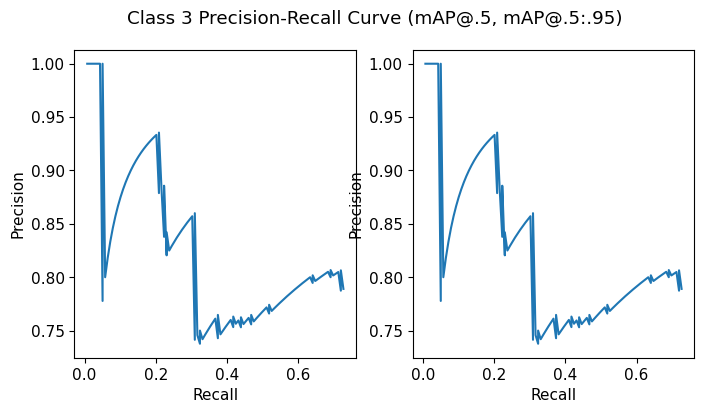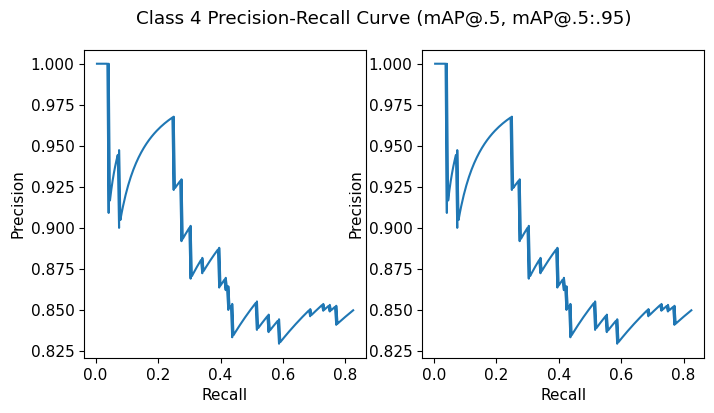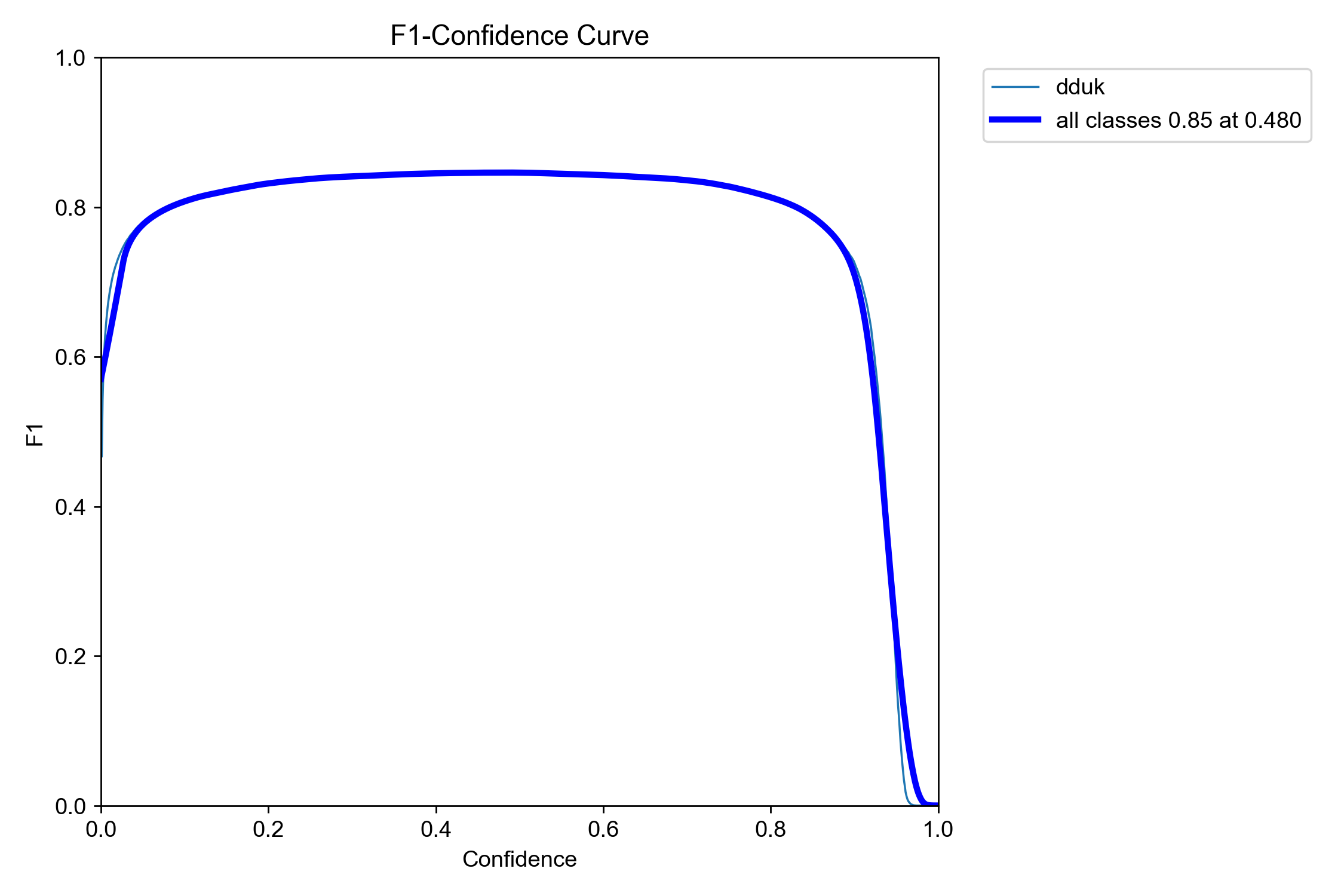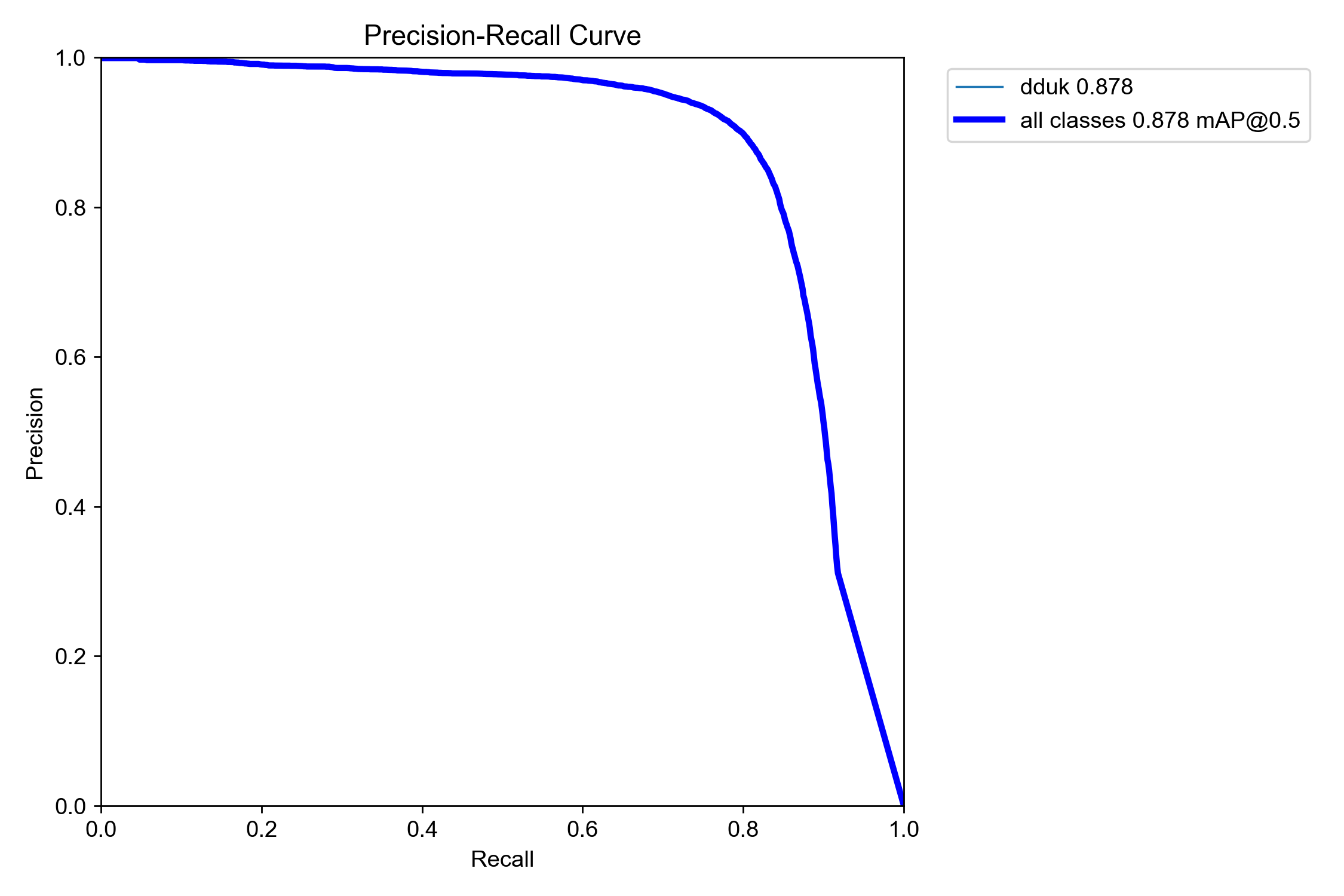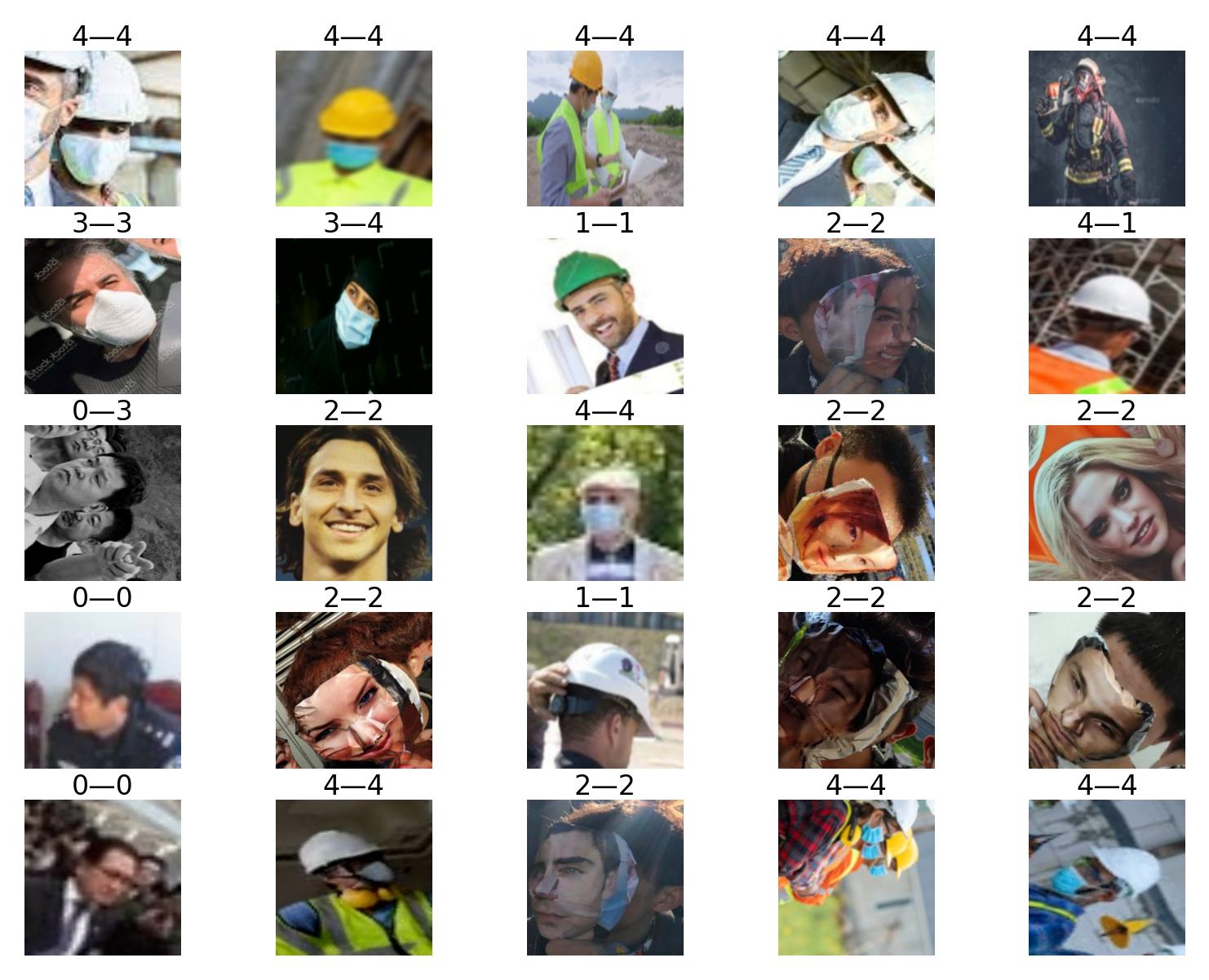You cannot select more than 25 topics
Topics must start with a letter or number, can include dashes ('-') and can be up to 35 characters long.
|
|
1 year ago | |
|---|---|---|
| images | 1 year ago | |
| runs | 1 year ago | |
| README.md | 1 year ago | |
| val_dduk.ipynb | 1 year ago | |
README.md
지능화 캡스톤 프로젝트 #2 - YOLOv5 안전모 검출
- 제출했던 프로젝트 코드가 날라가서 일부만 존재함;;
YOLOv5 GitHub
프로젝트 목표
- YOLOv5 모델을 학습하여 영상의 안전모와 마스크를 검출
구현 방법
- 일반적인 1개의 모델로 여러 클래스를 학습하지 않고, Detect Model로 머리를 검출하여 ROI 취득 후, 해당 ROI를 Crop하여 Classification Model로 안전모, 마스크, 미착용 등을 분류한다.
데이터셋
- YouTube, Google, AIHub, Kaggle에서 안전모 관련 데이터셋 확보
- Roboflow에서 데이터셋 라벨링 진행 Roboflow
클래스
Detect Model
- 1개의 뚝배기 클래스
- 0: dduk
Classification Model
- 5개의 클래스
- 0: head
- 1: helmet
- 2: face
- 3: mask
- 4: helmet & mask
프로젝트 코드 (Validation)
Import Packages
import os
import time
import cv2
import math
import numpy as np
%matplotlib inline
import matplotlib.pyplot as plt
import torch
import torch.nn.functional as F
from torchvision import transforms
from sklearn.metrics import accuracy_score
import yaml
device = torch.device('cuda' if torch.cuda.is_available() else 'cpu')
Classfication
def crop_and_classify(img, boxes, classification_model, transform):
# classification_model.to(device)
# classification_model.eval()
for box in boxes:
x1, y1, x2, y2 = box
# Expand the bounding box by 10%
width = x2 - x1
height = y2 - y1
x1 = max(int(x1 - 0.1 * width), 0)
y1 = max(int(y1 - 0.1 * height), 0)
x2 = min(int(x2 + 0.1 * width), img.shape[1] - 1)
y2 = min(int(y2 + 0.1 * height), img.shape[0] - 1)
# Crop the image
cropped_img = img[y1:y2, x1:x2]
# Transform the image to fit the input size of the classification model
transformed_img = transform(cropped_img)
transformed_img = transformed_img.unsqueeze(0)
# Classify the cropped image
with torch.no_grad():
outputs = classification_model(transformed_img)
_, predicted = torch.max(outputs.data, 1)
confidence = torch.nn.functional.softmax(outputs, dim=1)[0][predicted].item()
# Print the classification result
print(f"Class: {predicted.item()}, Confidence: {confidence:.2f}")
# Draw the bounding box and classification result on the image
cv2.rectangle(img, (x1, y1), (x2, y2), (0, 255, 0), 2)
cv2.putText(img, f"Class: {predicted.item()}, Confidence: {confidence:.2f}", (x1, y1 - 10), cv2.FONT_HERSHEY_SIMPLEX, 0.9, (0,255,0), 2)
return img
Detection
def run_detection_model(img, model_detect):
# img = transforms.ToTensor()(img).unsqueeze(0).to(device) # Convert image to tensor and add batch dimension
# model_detect.eval() # Set model to evaluation mode
img = transforms.ToTensor()(img).unsqueeze(0)
# Move the model to the GPU
model_detect = model_detect.to(device)
# Run inference
with torch.no_grad():
detections = model_detect(img)
# Extract bounding boxes and confidence scores
boxes = detections.pred[0][:, :4].cpu().numpy().tolist()
scores = detections.pred[0][:, 4].cpu().numpy().tolist()
return boxes, scores
Load detection model
weights_detect = "C:/Users/pinb/Desktop/pytorch/yolov5/runs/train/dduk_64_/weights/best.pt"
model_detect = torch.hub.load('ultralytics/yolov5', 'custom', path=weights_detect)
model_detect = model_detect.to(device).eval()
Using cache found in C:\Users\pinb/.cache\torch\hub\ultralytics_yolov5_master
YOLOv5 2023-6-12 Python-3.10.9 torch-1.12.1 CUDA:0 (NVIDIA GeForce RTX 3060, 12288MiB)
Fusing layers...
Model summary: 157 layers, 7012822 parameters, 0 gradients, 15.8 GFLOPs
Adding AutoShape...
Load classification model
weights_cls = "C:/Users/pinb/Desktop/pytorch/yolov5/runs/train-cls/dduk_cls3/weights/best.pt"
model_cls = torch.hub.load('ultralytics/yolov5', 'custom', path=weights_cls)
model_cls = model_cls.to(device).eval()
Using cache found in C:\Users\pinb/.cache\torch\hub\ultralytics_yolov5_master
YOLOv5 2023-6-12 Python-3.10.9 torch-1.12.1 CUDA:0 (NVIDIA GeForce RTX 3060, 12288MiB)
Fusing layers...
Model summary: 117 layers, 4173093 parameters, 0 gradients, 10.4 GFLOPs
WARNING YOLOv5 ClassificationModel is not yet AutoShape compatible. You must pass torch tensors in BCHW to this model, i.e. shape(1,3,224,224).
Load YAML
# # YAML 파일 경로
yaml_path = "C:/Users/pinb/Desktop/pytorch/yolov5/runs/detect/test/data.yaml"
def read_dataset_paths(file_path):
with open(file_path, 'r') as file:
data = yaml.safe_load(file)
test_path = data.get('test')
train_path = data.get('train')
val_path = data.get('val')
return os.path.join(os.path.dirname(file_path), val_path)
# # YAML 파일에서 데이터셋 경로 읽기
val_path = read_dataset_paths(yaml_path)
# 이미지가 있는 폴더 경로
folder_path = val_path
result_path = os.path.join(folder_path, "result")
# folder_path = "C:/Users/pinb/Desktop/pytorch/yolov5/runs/detect/test/"
# result_path = "C:/Users/pinb/Desktop/pytorch/yolov5/runs/detect/test/result"
def get_image_and_label_paths(folder_path):
image_paths = []
label_paths = []
for file_name in os.listdir(folder_path):
if file_name.endswith(".bmp") or file_name.endswith(".jpg") or file_name.endswith(".png"):
image_path = os.path.join(folder_path, file_name)
image_paths.append(image_path)
file_name = os.path.splitext(file_name)[0] + ".txt"
label_path = folder_path.replace("images", "labels")
label_path = os.path.join(label_path, file_name)
if os.path.exists(label_path):
label_paths.append(label_path)
else:
label_paths.append("")
return image_paths, label_paths
# 폴더 내의 이미지 파일 경로들을 가져옴
image_paths, label_paths = get_image_and_label_paths(folder_path)
if not os.path.exists(result_path):
os.makedirs(result_path)
Read Label Data
def read_label(label_path):
labels = []
with open(label_path, 'r') as file:
lines = file.readlines()
for line in lines:
label = line.strip().split(' ')
label_class = int(label[0])
bounding_box = tuple(map(float, label[1:]))
labels.append((label_class, bounding_box))
return labels
Find closet label class
def find_closest_label_class(pred_box, labels):
min_distance = float('inf')
closest_class = -1
for i, label in enumerate(labels):
label_box = label[1]
label_center_x = (label_box[0] + label_box[2]) / 2
label_center_y = (label_box[1] + label_box[3]) / 2
pred_center_x = (pred_box[0] + pred_box[2]) / 2
pred_center_y = (pred_box[1] + pred_box[3]) / 2
distance = math.sqrt((label_center_x - pred_center_x) ** 2 + (label_center_y - pred_center_y) ** 2)
if distance < min_distance:
min_distance = distance
closest_class = label[0]
return closest_class
Evaluate
lst_result = [[],[],[],[],[]] # class 0~4
eval_times = []
def Evaluate(model_detect, model_cls, img, img_name, labels, output=True):
height, width, _ = img.shape
expand_ratio = 0.5 # The ratio to expand the ROI area
# Inference detection model
start_time = time.time()
results = model_detect(img)
# For each detection, crop the ROI and classify it
for *box, detect_conf, cls in results.xyxy[0]:
x1, y1, x2, y2 = map(int, box)
fbox = map(float, box)
# Calculate the width and height of the bounding box
bbox_width = x2 - x1
bbox_height = y2 - y1
roi = (x1, y1, bbox_width, bbox_height)
# Calculate the expanded coordinates
x1_expanded = max(0, x1 - int(bbox_width * expand_ratio))
y1_expanded = max(0, y1 - int(bbox_height * expand_ratio))
x2_expanded = min(width, x2 + int(bbox_width * expand_ratio))
y2_expanded = min(height, y2 + int(bbox_height * expand_ratio))
roi_flat = (x1_expanded,
y1_expanded,
bbox_width + int(bbox_width * expand_ratio) * 2,
bbox_height + int(bbox_height * expand_ratio) * 2)
# Crop the expanded ROI from the image
# roi = img[y1:y2, x1:x2]
roi_expanded = img.copy()
roi_expanded = roi_expanded[y1_expanded:y2_expanded, x1_expanded:x2_expanded]
roi_expanded = cv2.resize(roi_expanded, (224, 224))
# Convert numpy array to torch tensor, and normalize pixel values
roi_expanded = torch.from_numpy(roi_expanded).float().div(255.0)
# Reshape tensor to (channels, height, width)
roi_expanded = roi_expanded.permute(2, 0, 1)
# Add an extra dimension for the batch
roi_expanded = roi_expanded.unsqueeze(0)
# Move roi_expanded to the same device as class_model
roi_expanded = roi_expanded.to(device)
class_result = model_cls(roi_expanded)
# classfication result
probabilities = F.softmax(class_result, dim=1)
max_confidence, max_indices = torch.max(probabilities, dim=1)
class_pred = max_indices.item()
class_conf = max_confidence.item()
# confidence
total_conf = (detect_conf + class_conf) * 0.5
# label - class
class_gt = find_closest_label_class((x1, y1, x2, y2), labels)
# append (class, confidence, bounding box)
lst_result[class_pred].append((class_pred, class_gt, total_conf, (x1, y1, x2, y2)))
# Put classification result on each ROI
thin = 1
color = ()
if class_pred == 0: # head
color = (0, 0, 255)
elif class_pred == 1: # helmet
color = (255, 0, 0)
elif class_pred == 2: # face
color = (0, 255, 0)
elif class_pred == 3: # mask
color = (255, 0, 255)
elif class_pred == 4: # helmet & mask
color = (255, 255, 0)
cv2.putText(img, f'{class_pred}: {total_conf}', (x1, y1 - 10), cv2.FONT_HERSHEY_SIMPLEX, 0.5, color, thin)
# cv2.rectangle(img, roi_flat, color, thin)
cv2.rectangle(img, roi, color, thin)
if output is True:
print(f'{img_name}\'s det + cls result [{class_pred}]: {total_conf}%, {roi}:')
end_time = time.time()
total_time = end_time - start_time
eval_times.append(total_time)
if output is True:
print(f'Detect + Classfication Time: {total_time}s')
# Save image
cv2.imwrite(f'{result_path}/{img_name}_rst.jpg', img)
Compare Ground Truth & Bounding Box
# Class
# 0: head
# 1: helmet
# 2: face
# 3: mask
# 4: helmet & mask
def CompareClass(pr, gt):
if gt == 0: # head or face
if pr == 0 or pr == 2:
return True
else:
False
elif gt == 1: # helmet or mask
if pr == 1 or pr == 3 or pr == 4:
return True
else:
return False
def CompareGTandBox(predict, setting_mAP=0):
# 0: mAP@.5, 1: mAP@.5:.95 0
# 비교하여 TP와 FP 구분
results = []
tp_cnt = 0
fp_cnt = 0
totalbox_cnt = 0
targetbox_cnt = len(predict)
for p_class, gt_class, confidence, p_box in predict:
if CompareClass(p_class, gt_class):
# iou = calculate_iou(p_box, l_box)
# iou = confidence
if setting_mAP == 0: # mAP@.5
if confidence >= 0.5:
# True Positive (TP)
tp_cnt = tp_cnt + 1
totalbox_cnt = totalbox_cnt +1
# class, confidence, boudingbox, TP/FP, precision, recall
results.append((p_class, confidence, p_box, True, tp_cnt/totalbox_cnt, tp_cnt/targetbox_cnt))
elif setting_mAP == 1: # mAP@.5:.95
if confidence >= 0.5 and confidence < 0.95:
# True Positive (TP)
tp_cnt = tp_cnt + 1
totalbox_cnt = totalbox_cnt + 1
# class, confidence, boudingbox, TP/FP, precision, recall
results.append((p_class, confidence, p_box, True, tp_cnt/totalbox_cnt, tp_cnt/targetbox_cnt))
else: # all P, R
tp_cnt = tp_cnt + 1
totalbox_cnt = totalbox_cnt + 1
results.append((p_class, confidence, p_box, True, tp_cnt/totalbox_cnt, tp_cnt/targetbox_cnt))
else:
# False Positive (FP)
totalbox_cnt = totalbox_cnt + 1
results.append((p_class, confidence, p_box, False, tp_cnt/totalbox_cnt, tp_cnt/targetbox_cnt))
return results
Get Precisions, Recalls and PR Curve
def GetPR(results):
results = sorted(results, key=lambda x: x[5], reverse=True)
# results = sorted(results, key=lambda x: x[1], reverse=True)
precisions = [item[4] for item in results]
recalls = [item[5] for item in results]
return precisions, recalls
Calculate AP
def calculate_AP(precisions, recalls):
assert len(recalls) == len(precisions)
sorted_indices = sorted(range(len(recalls)), key=lambda i: recalls[i])
sorted_precisions = [precisions[i] for i in sorted_indices]
sorted_recalls = [recalls[i] for i in sorted_indices]
ap = 0
for i in range(1, len(sorted_recalls)):
recall_diff = sorted_recalls[i] - sorted_recalls[i-1]
ap += recall_diff * (sorted_precisions[i] + sorted_precisions[i-1]) * 0.5
return ap
Run
lst_result = [[],[],[],[],[]] # class 0~4
eval_times = []
for i in range(0, len(image_paths)):
# Image name
img_dir = os.path.dirname(image_paths[i])
img_name = os.path.basename(image_paths[i])
# Load image
img = cv2.imread(image_paths[i])
img = cv2.resize(img, (640, 640))
labels = read_label(label_paths[i])
Evaluate(model_detect, model_cls, img, img_name, labels, False)
Ps = []
Rs = []
ap5s = []
ap95s = []
# Class
# 0: head
# 1: helmet
# 2: face
# 3: mask
# 4: helmet & mask
# each class result
class_len = len(lst_result)
for i in range(0, class_len):
results_all = CompareGTandBox(lst_result[i], -1) # all P, R
results_5 = CompareGTandBox(lst_result[i], 0) # mAP@.5
results_95 = CompareGTandBox(lst_result[i], 1) # mAP@.5:.95
p, r = GetPR(results_all)
p1, r1 = GetPR(results_5)
p2, r2 = GetPR(results_95)
ap1 = calculate_AP(p1, r1)
ap2 = calculate_AP(p2, r2)
# print(p1)
# print(r1)
# print(p2)
# print(r2)
if len(p) != 0:
p = sum(p) / len(p)
else:
p = 0
if len(r) != 0:
r = sum(r) / len(r)
else:
r = 0
Ps.append(p)
Rs.append(r)
ap5s.append(ap1)
ap95s.append(ap2)
print(f'Class {i}')
print(f'meanP:', p)
print(f'meanR:', r)
print(f"AP@.5:", ap1)
print(f"AP@.5:.95:", ap2)
fig, axs = plt.subplots(1, 2, figsize=(8, 4))
axs[0].plot(r1, p1)
axs[0].set_xlabel('Recall')
axs[0].set_ylabel('Precision')
axs[1].plot(r2, p2)
axs[1].set_xlabel('Recall')
axs[1].set_ylabel('Precision')
plt.suptitle(f'Class {i} Precision-Recall Curve (mAP@.5, mAP@.5:.95)')
print()
# plt.tight_layout()
plt.show()
mP = sum(Ps) / class_len
mR = sum(Rs) / class_len
mAP_5 = sum(ap5s) / class_len
mAP_95 = sum(ap95s) / class_len
mean_time = sum(eval_times) / len(eval_times)
print(f'==> Union Model (Detection + Classification) - 5 classes')
print(f'[mean Precisions] {mP}')
print(f'[mean Recalls] {mR}')
print(f'[mAP@.5] {mAP_5}')
print(f'[mAP@.5:.95] {mAP_95}')
print(f'[mean time] {mean_time}s')
print()
#### Convert to evaluate ####
# Class
# 0: head
# 1: helmet
# 2: face
# 3: mask
# 4: helmet & mask
# => Model 1: (0, 2, 3) - head, (1, 4) - helmet
# => Model 2: (0, 1, 2) - face, (3, 4) - mask
print(f'==> Convert to Model 1')
print(f'[mean Precisions] {((Ps[0] + Ps[2] + Ps[3]) / 3 + (Ps[1] + Ps[4]) / 2) / 2}')
print(f'[mean Recalls] {((Rs[0] + Rs[2] + Rs[3]) / 3 + (Rs[1] + Rs[4]) / 2) / 2}')
print(f'[mAP@.5] {((ap5s[0] + ap5s[2] + ap5s[3]) / 3 + (ap5s[1] + ap5s[4]) / 2) / 2}')
print(f'[mAP@.5:.95] {((ap95s[0] + ap95s[2] + ap95s[3]) / 3 + (ap95s[1] + ap95s[4]) / 2) / 2}')
print(f'[mean time] {mean_time}s')
print()
print(f'==> Convert to Model 2')
print(f'[mean Precisions] {((Ps[0] + Ps[1] + Ps[2]) / 3 + (Ps[3] + Ps[4]) / 2) / 2}')
print(f'[mean Recalls] {((Rs[0] + Rs[1] + Rs[2]) / 3 + (Rs[3] + Rs[4]) / 2) / 2}')
print(f'[mAP@.5] {((ap5s[0] + ap5s[1] + ap5s[2]) / 3 + (ap5s[3] + ap5s[4]) / 3) / 2}')
print(f'[mAP@.5:.95] {((ap95s[0] + ap95s[1] + ap95s[2]) / 3 + (ap95s[3] + ap95s[4]) / 2)}')
print(f'[mean time] {mean_time}s')
print()
Class 0
meanP: 0.2451500387154128
meanR: 0.1266693073789041
AP@.5: 0.056300405455419165
AP@.5:.95: 0.056300405455419165
Class 1
meanP: 0.8831870385742567
meanR: 0.43243055555555554
AP@.5: 0.6344911937169155
AP@.5:.95: 0.6344911937169155
Class 2
meanP: 0
meanR: 0
AP@.5: 0
AP@.5:.95: 0
Class 3
meanP: 0.8349450369473351
meanR: 0.40800165622897366
AP@.5: 0.591933273620593
AP@.5:.95: 0.591933273620593
Class 4
...
meanR: 0.43473958333333357
AP@.5: 0.727062010345605
AP@.5:.95: 0.727062010345605
==> Union Model (Detection + Classification) - 5 classes
[mean Precisions] 0.5704349663931353
[mean Recalls] 0.2803682204993534
[mAP@.5] 0.40195737662770653
[mAP@.5:.95] 0.40195737662770653
[mean time] 0.042649137104018055s
==> Convert to Model 1
[mean Precisions] 0.6230357850195234
[mean Recalls] 0.3059043619902019
[mAP@.5] 0.4484272475282988
[mAP@.5:.95] 0.4484272475282988
[mean time] 0.042649137104018055s
==> Convert to Model 2
[mean Precisions] 0.6190156182172799
[mean Recalls] 0.30386862037965345
[mAP@.5] 0.3349644805230888
[mAP@.5:.95] 0.8897615083738772
[mean time] 0.042649137104018055s
결과
참고¶
- 지능화캡스톤 과목, 김현용 교수



